If you have goals to change your body composition, learning how to accurately take body measurements for weight loss is an important piece of a successful journey.
The weight on the scale, body measurements, and progress pictures are the three main pieces of the body composition puzzle. Today, we’ll break down each of these factors and provide tips, tricks, and considerations for each.
But, before throwing you our biggest suggestions when taking body measurements for weight loss, we need to cover why this matters in the first place and who may benefit from this kind of metric tracking.
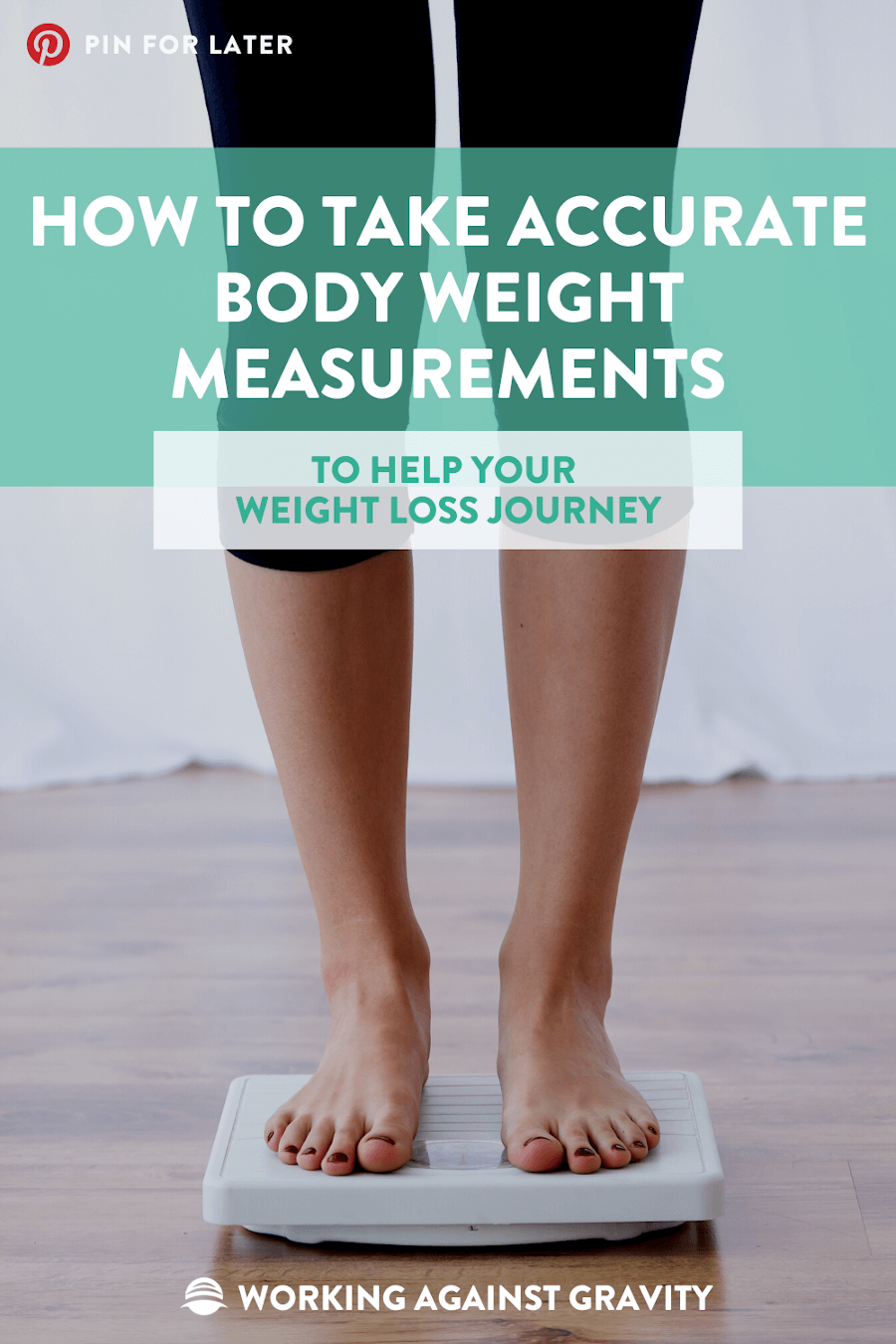
Why Does Taking Body Measurements Matter for Weight Loss?
Accurate data — on the scale, with body measurements, and when taking progress photos — is a key component in creating a reliable picture you (and your coach) can use to make knowledgable changes to your nutrition program.
Progress can slow when measurements are incomplete or downright inaccurate which increases frustration with the process and may even make you want to quit trying altogether. So, learning how to accurately take and evaluate these measurements is an extremely important part of a sustainable weight loss journey.
Advertisement
All that being said, there are certain situations when weighing yourself may not be in your best interest.
Who Needs to Precisely Measure Weight Loss?
A weight loss journey is ever-changing and has ebbs and flows. There are times when you may need to be more precise with your nutrition and measurements so you can get optimal, complete data and see faster progress.
You may need to precisely measure weight loss if:
- You’re competing in a weight-specific sport (like Olympic weight lifting or Brazilian jujitsu) and have to be a certain weight at an exact time.
- You want to lose weight before a special event like a wedding or before a physical test like a half-marathon or CrossFit competition.
- You’re just getting started on your nutrition journey — this is a time when accurate information enables you and your coach to figure out what macros or overall plan works for your body and what may need to change.
- You want to see weight loss progress happen as quickly as possible.
Who Doesn’t Need to Precisely Measure Weight Loss?
On the flip side, there may be times when putting away one (or many) of the different tracking metrics could be advantageous to your overall mental and physical health.
You may not need to precisely measure weight loss if:
Advertisement
- You’re at a body weight and composition you’re comfortable with and have a general idea of the macros or nutrition plan to maintain it.
- You’re taking a diet break because of a vacation or other circumstance where weighing yourself and tracking measurements may take up mental and/or physical time and energy.
- You’re okay with slower (but still steady!) weight loss.
- You’ve dealt with emotional or physical struggles in the past when weighing yourself regularly and know that it is a triggering metric to keep tabs on.
Accurately Measuring Your Body Weight Changes
Body weight taken on a floor scale is the most commonly used measure of weight loss. The catch is that hopping on the scale once a week isn’t giving you the full (or true) story of what is happening with your body weight trends.
Because many things can impact the weight you see on the scale (from what time you ate dinner and woke up, to stress levels and sleep quality), one weekly data point isn’t able to accurately account for all of the daily fluctuations.
If you fall under the “Who Needs to Precisely Measure Weight Loss?” category above, we recommend taking your weight every morning, finding your weekly average, and then comparing each weekly average to assess true, average weight loss from week to week. This will be a much more accurate representation of what is going on in your body.
Need an example?
Check-in with your WAG Coach #1: Sunday night you eat a well-balanced meal at 7:00 pm, go to sleep around 9:00 pm, wake up at 7:00 am on Monday, and weigh in at 141lbs.
Advertisement
Over the course of the week, you actually lose .7lbs.
Check-in with your WAG Coach #2: Sunday night you eat a saltier meal at 8:30 pm because you got stuck late at work and had to grab take-out on your way home. You go to bed at 11:00 pm and wake up at 6:00 am on Monday. You weigh in at 141.5 because you ate later at night, weighed yourself an hour earlier and you're holding onto water from the salt you ate the night before.
If you only had those two weights, it would look like you gained .5lbs and you’d likely think your nutrition plan wasn’t working for you. Maybe you’d even change your macros unnecessarily which could lead to more hunger, a dip in energy/mood, and slower progress overall. No good, right?
But, if you weighed yourself every day, your weight trended down through the week, and then had a small, quick spike the morning you weighed in, the weekly average would still show an accurate .7lb loss. You’d carry on with your plan, confident that you were on the right track to reach your goals.
Tips For Taking Your Weight
Accuracy is key when taking your weight. This limits frustration and ensures you and your coach can make knowledgeable changes to your plan. Here are a few best practices to stay on top of.
Advertisement
- Take your weight first thing in the morning before eating/drinking anything or engaging in any exercise. Food, fluids, and movement can impact the number you see on the scale. Weighing yourself first thing in the morning keeps these factors as consistent as possible from one day to the next.
- Take your weight with no/minimal clothing. If you’re uncomfortable hopping on the scale in your birthday suit, keep clothing minimal and consistent from one morning to the next. Different clothes have varying weights and can skew the number you see. Keep things consistent by wearing no clothes or the same/very similar clothes every time you weigh yourself.
- Remember the factors that can impact the number you see on the scale. The scale can be a mind game, we totally get it. Ask yourself if any of these factors could be at play so you’re not overly emotionally invested in the number you see. Remember it is all about the average and daily weight fluctuations are very, very normal.
At WAG Nutrition, our coaching software, Seismic, does all the math for you and your coach. Enter your weight into your logs each day (left photo) and Seismic will calculate your weekly average and track changes over time (middle photo).
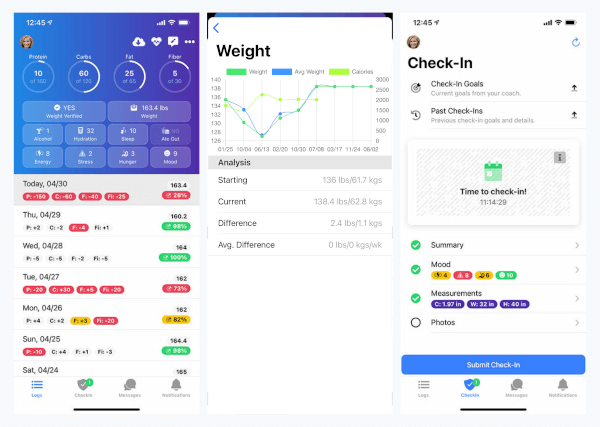
In your check-in (right photo), you’ll send in your macro logs, a written summary, and daily weights (remember, it will do the “weekly average” math for you.). You’ll also take weekly body measurements and progress photos.
Why do we ask for these two weekly metrics along with your body weight? Well, your physical weight doesn’t tell the full story of what is going on in your body. A lot can happen with body composition (the aesthetic result of the ratio of your muscle mass to body fat) that isn’t necessarily “shown” on the scale. So, let’s dive into the next of the three metrics: body measurements.
What Body Parts Do You Measure for Weight Loss?
Measurements can sometimes be more telling than weight when it comes to how your body is physically changing and where weight may be coming off.
Advertisement
Unlike body weight which fluctuates from day to day and throughout the day as you eat, train, sweat, and rehydrates, body measurements stay a bit more steady and may change more slowly. That’s why we recommend taking them once per week, on the same day each week.
Tips For Measuring Body Parts for Weight Loss
Here are best practices to keep in mind as you take your body measurements.
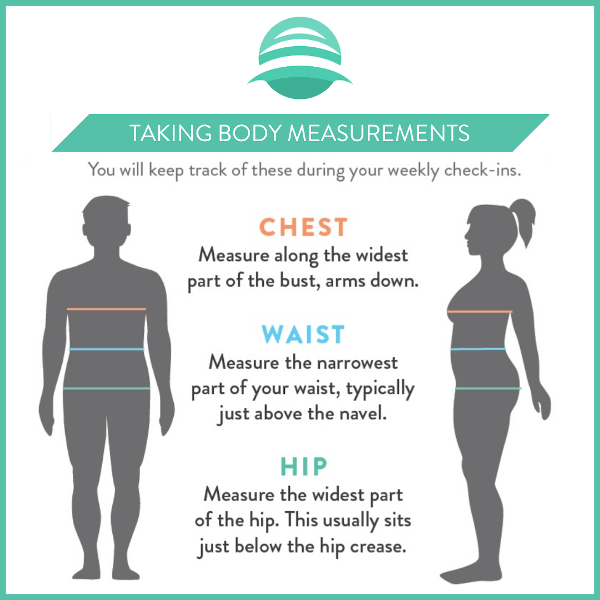
- Keep the location consistent from week to week - At WAG, we ask that our clients take chest, waist, and hip measurements. Use “body landmarks” to ensure you’re measuring in the same place each week. This could look like “chest” at the nipples, “waist” at the belly button, and “hips” at the widest part of your bum.
- Take your measurements first thing in the morning before exercising, eating, or drinking. The same reasons apply here! This keeps things consistent and takes external factors out of play.
- From there, add the locations that matter to you. If you want to take other measurements, go for it (bicep measuring competition, anyone?). Just keep that “landmark” in mind.
- Also, remember that measurements may take a while to change. It is okay if you’re not seeing change every week. Some of the same factors that influence daily body weight can influence measurements (ex: if you’re more bloated around your cycle) so keep those in mind as well.
- Go slow and steady. Make sure your tape measure is flush to your skin with no twists, folds, sags, or wrinkles. Pull it so it is taught but not tight. Trying to get smaller measurements by squeezing your skin will lead to inaccuracy and frustration long term. And, even if you’re nailing your measuring tape best practices, remember that there will be some human error! Measurements should be considered in the greater scheme of all three metrics along with weight and photos.
Speaking of photos, let’s cover the last of the three major body measurement metrics: weight loss progress photos.
How to Measure Body Composition with Pictures
Because you see your body change little by little every time you look in the mirror, it can be hard to acknowledge progress over time. Taking weekly photos allows you to compare changes side to side and celebrate your hard work.
Advertisement
Pictures are, perhaps, the most accurate look at how your body is changing. Although weight and measurements are easier to assess from a numbers perspective, you’ll be able to see what is going on in your body best with weekly progress pictures.
They are also a better representation of body composition and the change going on in your body as you lose fat and put on muscle. Muscle really does weigh more than fat. So, if you’ve paired your weight loss journey with a fitness plan, there could be a lot of change going on that you could completely miss if you are just focusing on body weight and/or measurements.
We recommend taking photos from the front, back, and each side so you can see your body and the change going on from different angles.
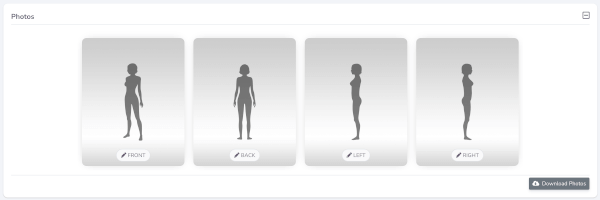
Seismic allows you to upload your four photos and then compare any past check-in photos side-to-side so you can see changes happening over small or long periods of time.
Advertisement
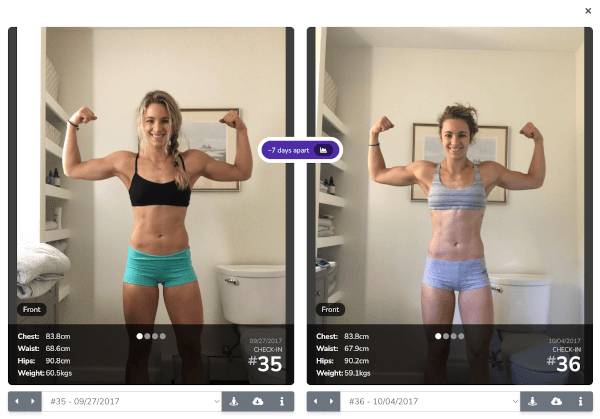
Tips For Measuring Body Composition
Just like with body weight and measurements, there are some things to stay on top of to ensure that the pictures you take are reliable when assessing your progress.
- Take your photos once a week on the same day each week. This keeps things regular and consistent.
- Take them first thing in the morning before exercising, eating, or drinking. You get it by now. ;)
- Wear similar (or the same), minimal clothing. For women, we suggest a bra and underwear or a bathing suit. For men, we suggest boxers. This allows you to see the most change vs. wearing baggy or concealing clothing.
- Try to keep lighting and angle as consistent as possible. shadows and changes in perspective can make it tricky to see change and measure it reliably.
- Take a selfie. If you have someone who can reliably take photos for you early in the morning, lucky you! But if you want to keep things consistent, relying on yourself to take your photos is your best bet. Try flipping your camera to selfie mode, setting it up on a dresser or shelf, setting a 3 (or 10!) second timer, hitting the button, and then taking a step back.
- Flex… or don't! If you’re already pretty lean and/or want to see changes in muscle size, flexing can be helpful. Otherwise, just take a neutral stance and keep it the same from week to week.
- Take a deep breath. Taking pictures can make you feel really vulnerable at first. But, it is really, really fun to look back and see how far you’ve come.
Putting It All Together
We’ve covered the three biggest metrics when it comes to taking body measurements for weight loss: body weight, body measurements, and composition progress photos.
These three metrics are best used in tandem with each other. But, at any point in your journey, one, two, or all of them can be dropped and picked back up based on your goals. There is no right or wrong, but an understanding of how each works, how to ensure you’re using them accurately and correctly, and how to change your program accordingly is key.
WAG Coaches are experts at helping you put together the different puzzle pieces of your weekly metrics and making knowledgable changes to support you in your health journey. They’re also a sounding board to remind you when a lack of change is normal and are able to point out the things that may need to change with your habits, food choices, and lifestyle to get your metrics moving.
Advertisement






